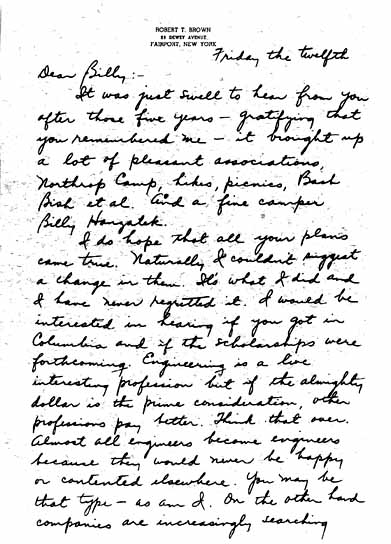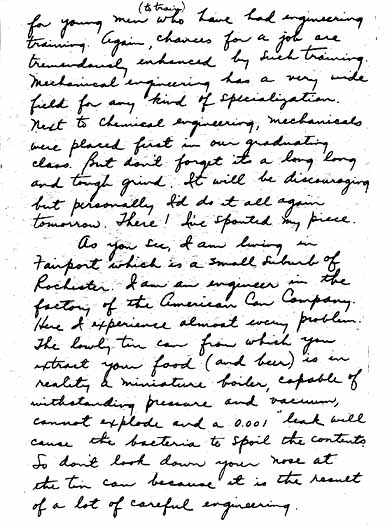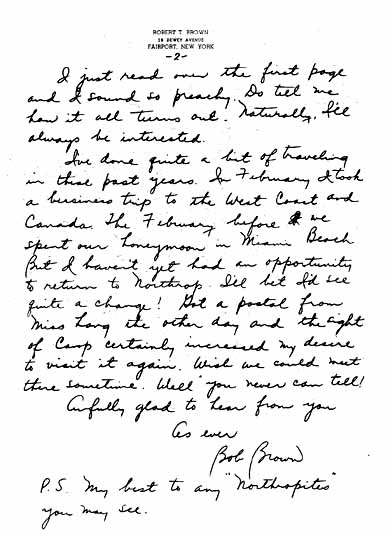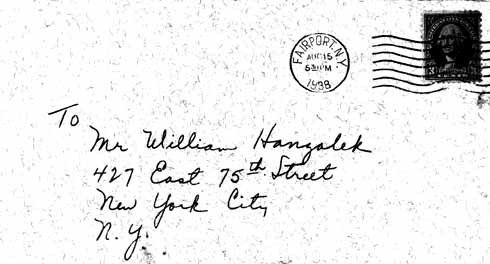history> Hall of Fame> Robert T. Brown
Alice Rich Northrop Memorial
Hall of Fame
For dedicated and distinguished service
Robert T. Brown
He served as athletics counselor for several boys' years
during the late 1920's and early 30's and
on the board for many years before his death in the 1970's.
Copy of NORTHROP CAMP DEDICATION SPEECH - by Bob Brown - August 18,1968
It is indeed a pleasure to also add my welcome to our Dedication exercises. We are here to dedicate this fine building, and to specifically pay homage to three very fine people ---Mrs. Alice Rich Northrop, Miss Emilie 0. Long and Miss Birdie E. Kallman, and also to the score of people ---friends and former students of these three; Board members and occasional workers or contributors who realized what a wonderful and pioneering idea had been contemplated here and who had wanted to contribute their part to this exciting group. But more about that later.
Let me first share with you my pleasure in reminiscing and take you down my own memory lane. I hope I won't bore you. When I first came to Camp in 1926, I little thought that 42 years later I would be standing here to help dedicate this beautiful ground-hugging spanking-new building that Mr. Anicka designed for us. We tried so hard to make it fit and be a part of our beloved mountain.
In its very beginning, the Camp was founded through the generosity and foresightedness of Mrs. Alice Northrop, a professor of botany at Hunter College, a great nature lover, and a close friend of some of the most prominent naturalists and conservationists of the era, including among others, the well-known John Burroughs. I never had the privilege of meeting her, but I am told she loved her home here on the mountain, having bought it and 500 acres after it had served for many years as a boarding house. She was evidently very unselfish and wanted to share her joy and appreciation in the busy world of nature
around her. She wanted young people, less fortunate than she, to learn the satisfactions in nature and to continue in its appreciation long after she, and you and I, had passed on.
Accordingly, she translated her wishes into action and set about turning this mountain home into a haven for the less fortunate children of New York City and environs. She dreamed of snatching them in the summer, from the hot asphalt city streets and transporting them up here to Mt. Washington where they could learn first hand of sky, of trees, of grass, of birds, of mammals. She decided at once that there would be no condition of admittance except three: 1. The prospect must be deserving; 2. he or she must be free of communicable diseases (but preferably underweight or under nourished); and 3. should exhibit an elementary interest in nature from first indoctrination in school nature courses.
On her way up to Camp in 1923 to make final arrangements for the arrival of the first contingent of campers, her car was struck at a grade crossing and she was instantly killed.
Her grief-stricken associates and former students spontaneously decided to carry on. The Misses Long and Kallman, along with many of Mrs. Northrop*s friends (including some still on our Board) formed the Alice Rich Northrop Memorial Camp, and through such generous support, purchased her home. It became affiliated with the New York City School Nature League and the Audubon Society. Mrs. Edna Isaacs will later tell you of the hundreds who have passed through the portals of this Camp and how we number many prominent citizens as alumni of Northrop and yes....of our Board of Directors. Rose Geoghan, another Board
member, will tell you of her experience here as a camper.
I was in college in 1926 and I first came here that summer as an athletic counselor. As you know, each year we alternate between boys and girls. In girls' year I acted as maintenance man, lawn mower, chauffeur and wherever I could be helpful. Like so many who came to Northrop, already it was getting into my blood and I was being forever enslaved. The service years of many of our Board members is testimony to that!
From its very inception, its founders had one unvarying policy ---to do whatever was best for the overall welfare of the campers. Applications were chosen irrespective of color or of creed or of ethnic background. Mind you, this was long before the phrases of "civil liberties" of "integration" or other widely used terms were in existence. Our founders thought that their concept was right and proper and fitted into their visualization of man's innate and natural dignity. Succeeding members have fully subscribed to it and I believe and hope it will never change.
And so although the deep philosophy and policies of the Camp have remained essentially unaltered, its physical aspects fortunately have shown a gradual change; as fast as the monies available to us would allow. If you will indulge me for a few minutes, let me reminisce and try to show you how far we have come to today's dedication.
In 1926, Northrop had few of the conveniences we have have today. We had a telephone, yes, but it was an oaken, stand-up, crank type affair, which worked when no storm threatened on the horizon or when no tree happened to fall across its single wire. A dozen or so people around the mountain shared this party line and it was an excellent local newspaper. Our campers became trained to listen for our "4-2" ring and took great delight in shouting for an adult to answer it.
We used canvas tents, six in front of the old house, another for counselors and a big circus tent for congregating in rainy weather, story time or tribal functions. Sometime later, the present Rec Hall was built from an unused cow barn and replaced the circus tent. Some of the campers were housed in tents, the remainder in the old building. Tents had a peculiar and frustrating way of leaking on unsuspecting sleepers in the middle of the night or even going so far as to collapse over the kids, but later it was all fun, a good conversation piece and it made a hair-raising tale to include in the required weekly letter home. Not all the kids could get into the damp airless
tents, (airless, since the campers insisted that the flaps be kept closed at night against prowling and very savage wild animals). So the unfortunates (drawn by lot) lived in the Main House for half the time. There was always,the opportunity of being moved to a tent to replace a miscreant tenter who did not come up to Miss Long's standards of neatness. But wooden platforms rotted and had to be replaced too frequently. Each Spring the directors congregated before the opening of Camp to help lug out the heavy tents and stake them...truly an exhausting job. On your inspection tour of the Camp today, you have probably seen the six fine cabins which were completed about five years ago, and of which we are indeed very proud.
We had no electricity, since none had found its way up the Mountain, so flashlights at night were a unique experience as well as a necessity. At the end of the day's activities,
a camper from each room or tent col1ected his "Lan-turn"(as they called it) and used it to prepare for bed. Oh the chimney cleaning, refilling with kerosene and wick trimming that was almost a daily chore. I can still smell that kerosene.
Having no electricity, we had no refrigeration and so depended upon the coolness of the cellar floor. We had to drive (in Miss Long's Model T Ford) twice a day for milk, and if the weather turned hot and the milk soured, frugal Birdie Kallman made pot cheese.
Bathing was sketchy at best. The children used porcelain wash basins fed from two faucets in the now abandoned wash house. Wood had to be carried in each morning and night from the Wood House and stacked in the wood box alongside the cookstove. If the cook did a lot of cooking, then hot water became available to us in limited quantities with Miss Kallman standing guard at the control valve. We were given a short time to dunk, after which the over-indulgent and unwary got a bracing flood of cold spring water. Now we have bottled gas and a modern gas range.
The old Northrop Spring was, and still is, in existence across the road and up the Mountain above our present pool. It was then our only source of water and during a drought water of necessity had to be strictly rationed. We allowed our neighbors to pipe into it, but in times of shortage, we had no recourse but to close all connections, which didn't endear us to our friends. Now, through the generosity of Mr. Intemann, we have an artesian well.
As part of nature study, our founders felt that a young city inhabitant should acquire a first-hand knowledge of growing things and have a personal vegetable garden which he could tend and watch grow. From the outset, it was a losing battle with raccoons, rabbits and deer. No matter how high we made our homemade fences, the smaller animals could burrow underneath and the deer could easily vault them. Mr. Intemann again came forward and contributed the hurricane fence which has solved the animal prowler problem.
We had no pool, of course, and had to supplement instant showers with hikes down to the lake near the R.R. station, Bash-Bish Falls, or down to the Hairpin Turn. At the latter, we labored each year in manually moving seemingly tons of rocks to make a small icy pool, so all of four or five children could dunk at a time. Now we have our new pool (named after Miss Kallman) which has pumping engines, filters, skimmers, and what not.
We liked to hike a lot in those days---to Sunset Rock, Around-the-Block, Bash-Bish, to Spurrs, and finally to Mt. Everett. I still recall the songs we sang as we tramped along. One day we were going over the Northrop trail (I haven't heard mention of it in years and I suspect it is probably overgrown and the blazes healed) and I was leading the pack with Miss Long and Miss Kallman bring up the rear. Miss Long slipped on a mossy rock in a dry stream bed, fell and suffered a compound fracture of the leg. We applied a tournequet, and being on the track team (and then in shape), I ran down through the woods to Copake Falls, where we summoned a doctor. I recall he was very elderly and could climb only ten or fifteen feet when he would have to stop and rest. All this time the spectre of the tournequet was in our minds. The kids had cleared a broad boulevard to the road, others had fashioned a stretcher, and we got her to a hospital in Hudson.
On another hike, we were on the summit of Mt. Everett and I spied a trail down the mountain, seemingly headed toward camp. It was challenging and apparently a short-cut back. But once started, it stubbornly kept veering the wrong way and eventually I led my conga line down to the paved streets of Sheffield, Connecticut! My boys by this time were too exhausted to climb back up so I negotiated the loan of a dime and called on Miss Kallman for help. She sent a flat bed truck to fetch us back up the mountain, but here, note again, what a conversation piece this all proved to be.
Well, so much for the physical aspects of Northrop which after all, are matched by many camps around the country. But in one feature I like to think Northrop is unique, and I think this fixture is its soul, its conscience, its splendid group, its appeal which continues to draw all of us back year after year.
I refer particularly to the succession of wonderful and selfless people with which the Camp has been blessed---people who have been generous of their labor, of their time, and yes of their money. This building would never have been built without them. Personally, I have never been associated with such high types of dedicated individuals, who have brought Northrop to the level where it stands today.
Miss Long, a gentlewoman if ever there was one (I can hear her sputtering now, for she was very humble), extremely well-educated, soft spoken, an authority on ferns in her own right, a true inspiration to the children. Awed by her, yes, but I've seen many a lonesome hand steal into hers. Yet, on infrequent occasions, when her professional eyes flashed upon a hapless camper, order was immediately restored.
Birdie Kallmann was the alter ego of the duo. She was a pro teacher, extremely capable, generous, outgoing, the doer, the organizer, the one who wheedled and cajoled people into giving freely of their labor and support. You just couldn't resist the steam roller effect of Birdie and we all loved her for what she was and did. Camp is a monument to decades of their devotion, giving up every summer vacation for camp.
Doctor Petersen (Doc Pete as the kids called her) was a treasury of nature lore. She was an inspired teacher and nature counselor at Camp for many years, sharing with the campers her background in nature and sustaining that kindled interest through nature walks through city parks during the winter.
There are, and have been, so many others ---Dr. Langner, Mrs. Isaacs, Dr. Lewinson, Mrs. Wolff, Mr. Intemann, Mr. Anicka, Mr. and Mrs. Ruden---and many many others which time won't allow me to mention here, but whom I am slighting. All have carved their individual niches in Northrop's history.
I have tried to briefly outline what we had in the beginning and with what we had to "make do". We have certainly come a long way down the road through the helfulness and generosity of the many people whose contributions made all of this possible. That spirit, epitomized in Mrs. Northrop, Miss Long, and Miss Kallman will, and should act as an inspiration and a challenge to those who come after us to carry on this most worthy cause.
Thank you.
He is nominated by Bill Hanzalek.
Here is a 1938 letter from Robert Brown to Bill Hanzalek.




